CLAY SLING BALLS UNDER THE BED
In 2005 we have noticed a space covered with a clay lid in the floor, under the stair (from here was easy to go under bed, to take the sling balls). When we take out the bed, 30 clay sling balls were more or less spread here. Clay sling balls seem to be prepared, dry in the sun, more or less fired. When the dwelling burned, sling ball also burned (more or less in relation with fire intensity and air inside); some have traces or ashes or soot. Air comes only on the lateral side, and how long the bed structure was upraised, fire continues, fact demonstrated by some poles profiles, traces of transversal beams or ashes. From some images we can observe groups of seven-eight sling balls. These groups, different sort of firing of these pieces, their number help us to reconstruct semi-deepened hearth function.
Under the bed there were no traces of floor, fact that proves the bed has this function from the early beginning. Entirely or partially fired sling balls have been discovered (Lazarovici Gh. et alii 2001, I1.p. 33), in ovens (Ibidem, 31-32), in sanctuary for « sanctification » (Ibidem I.2, 43/4, down right), on the storey of some public dwellings, as the House of the Tribe (Ibidem, I.1, p. 151, fig. 114; I.2, 75/2-4). Even clay sling balls used by the attackers have been discovered in P9 (Ibidem, I.1, p. 107), P126 (Ibidem, I.1, p. 158, fig. 121 I.2, 29/2,4), where the altar and in side pieces have been bitten. About 20-25 sling balls are mentioned. In one of the ovens (after inventory we believe it is a domestic altar) 7 clay sling balls together with fragments of decorated pots have been deposited (Ibidem, I.1, p. 31). Some of these sling balls were partially fired, other continues to fire during the incense.
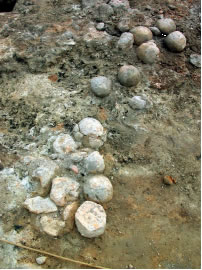
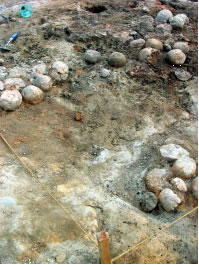
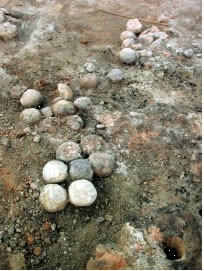
Fig. 48. Group of seven-eight clay sling balls under the bed, in different stages of firing
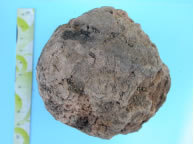
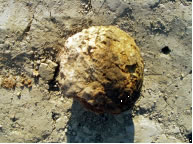
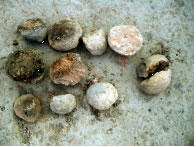
Firing of the clay sling balls. We believe that this operation took place in the semi-deepened hearth from the S room. Such sort of hearths are characteristic for nomadic people; such complexes are present in megalithic constructions (Monteneuf, France, photo Gh. Lazarovici).
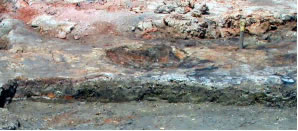
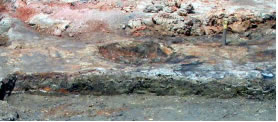
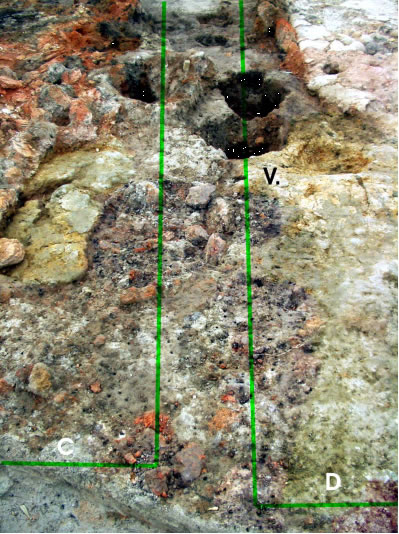
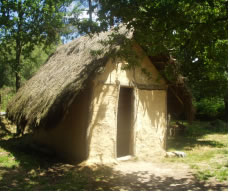
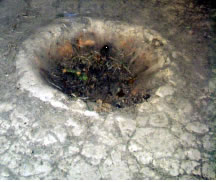
Fig. 49. Semi-deepened hearth in room D-South : a-c), d-e) Monteneuf, France ”The right stones”
In such a hearth 7-10 clay sling balls can be fired at once. Such a complex was found in room C, on one of the last phase clay plaster of the floor (fig. 55-56). The soil under the bed was not arranged. When the dwelling falls down (because of the thick of the floor bed, of the storey, of the wall ruins) many weak fired balls brake, other better fired slowly go into the ground.
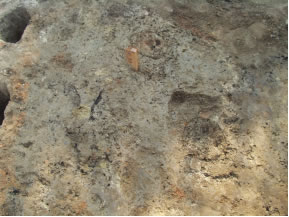
Fig. 50. Pit structures under the bed
Such situations are very important, showing the behavior of different objects during fire and fall down of the dwellings. Under the bed were half a pot and a stone tool, maybe polishing for bone objects.
One general statement regarding this « block » of houses is that space was very judicious and rational organized. Bed and storey dimensions, room numbers prove the existence of a big family with several generation members, or a related family that have lived here.
THE CORRIDOR
Between rooms A-B and C-D a space for circulation was preserved, that we call corridor; this space permit access to rooms A and D from the E side.
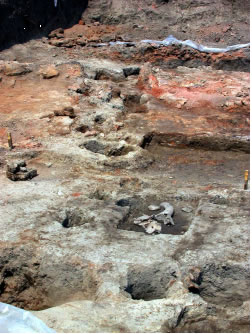
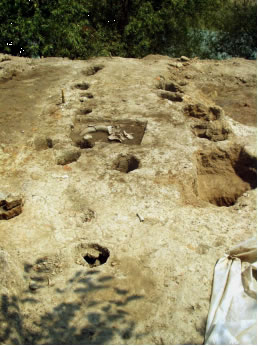
Fig. 51. Main corridor: a) view to the W ; b) view to the E
The E part of this space (to the river, squares AB) was destroying. The preserved part is still under investigation for the fallowing levels.
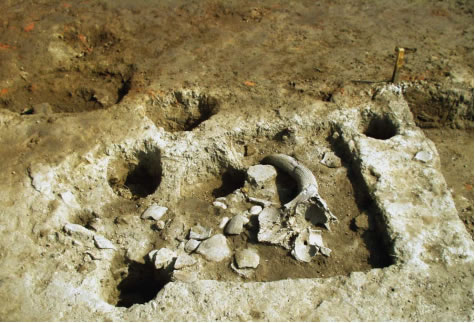
Fig. 52. Posthole and the bull forehead (right horn)
The corridor was 80-90 cm wide, a posthole have been discovered inside it. This corridor was necessary for access and for the postholes that sustain the roof (more for two slopes, only one if the roof has four slopes). Based on the actual situation, we believe it was a four slopes roof.
On the middle of the corridor we have discovered few archaeological materials, more close to the walls. In the area of the dividing wall between rooms A and D, a central posthole has been found, 20 cm thick. His foundation pit was not so deep and the bottom was straight right; this supposes that the post role was to sustain the beam of the roof. To the N there are other two closed postholes of the same size, but they are not in line with the S wall of the room D-south.
In the central posthole horizontally arranged potsherds and shells have been deposited. Some shells go until the limit of the posthole, but they did not have been cut (if we assume that posthole was latter dig). We do not exclude possibility that this posthole was latter dig out to sustain a beam that can not be used anymore to sustain the roof. In this case the posthole was not necessary to be very deep.
Close to the post to the E we have observed other foundation offerings: shards and shells, as before (in the N posthole together with the bull skull and horn).
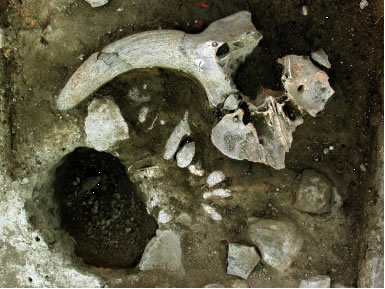
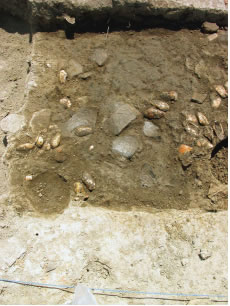
Fig. 53. Offerings : a) near the central post and to the N (b)
Many foundation offerings have been discovered at Parţa in many dwellings, most of them special, such as the foundation pits: pit 63 in Sanctuary 2, the huge ram horn under the monumental statue; in pit house 16 the bull skull; horn in altar 126, maybe fall down from the post; bull and deer horns in pit 121 (Lazarovici Gh. et alii 2001, p. 86, 175, fig. 140; I.2 fig. 41, 51/2 etc.; Lazarovici C.-M. & Gh. 2006, s.v. foundation offerings at Zorlenţu, Leu, Zau etc.). In this case connection of bull horn with shell shows the association of the several ideas: force, protection with purification.
A regular deposition or a ritual one is a grinding stone and a hearth fragment (last belonging to first living levels or to 7c) discovered in the area of room C.
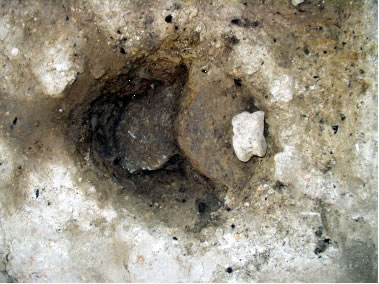
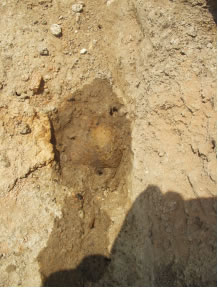
Fig. 54 a) Room C, posthole for the storey; b) shard , the NW corner of room D
These pieces have been arranged on horizontal. We believe they support the post from the storey floor.
In the central posthole an astragal (fig. 54a) was discovered too. This is coming from level 7c-7b. Half of a small amphora (fine clay) was deposited in the posthole of the NW corner of room C or B. In this posthole several posts have been noticed (fig. 54b) and the pot was between two of them.
FIREPLACES
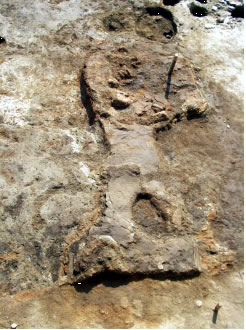
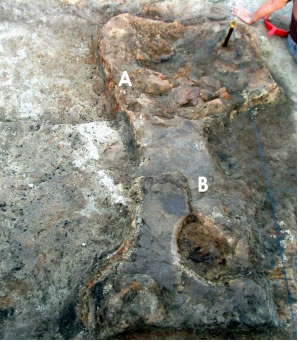
Fig. 55. Room C : a) semi-deepened fireplace; b) deepened fireplace
Two fireplaces were on the ground floor in room C (fig. 55). One irregular in the floor can be determined by a pit under the floor (fig. 55a). The second fireplace in a “D” shape has two clay plasters and is located on the floor used as an unmanaged fireplace under the ruins of the storey (fig. 56).
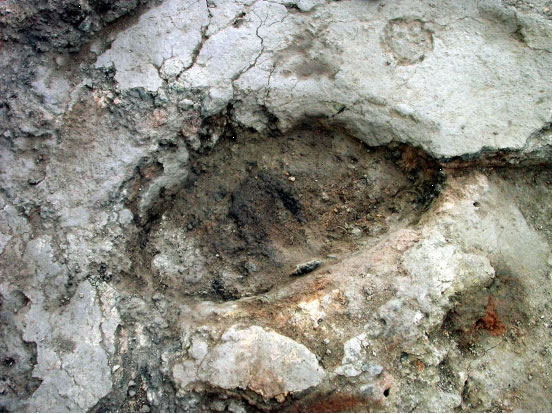
Fig. 56. Room C, hearth
The floor has two thin clay plasters and a thicker one, older (fig. 57b). On this floor in several places there are traces of unmanaged fireplaces, in use in the same time with the last two functional levels of the ovens.
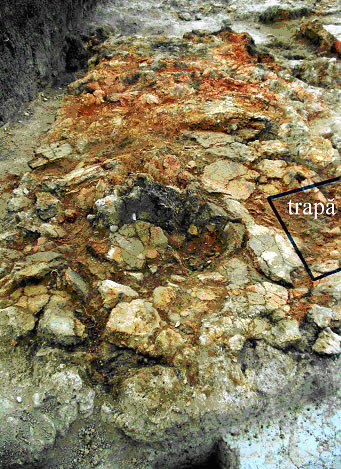
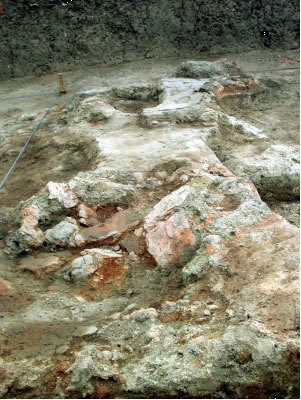
Fig. 57a. Floor storey disturbances over the fireplace; b) fireplace view to the W
This type of fireplaces was not discovered until now at Parţa. Research will be finished here on the next excavation season.
























